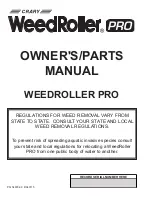
CHAPTER 2 –
Safety Information
Chap. 2
-
21
/
36 -
2.11.1 Noise hazard typical of the wood industry
The wood processing industry is traditionally characterised by processing operations with high-level
exposure to noise, due to a series of concomitant factors such as the use of equipment with elevated
sound power concentrated in work environments that are often small. The organisation of work
schedules typical of woodworking operations, where the interchangeable nature of tasks and variable
times for the use of equipment is the norm, makes it impossible to define the exposure of workers to
noise in a precise manner.
Here below are the emission values for the machine during a work cycle, for the purposes of example:
Material: beech wood parts; rough-milled, average thickness 25mm
Machining: milling and tenoning
Tools: HM hard metal mill; diameter 10mm
HM hard metal mill; diameter 18mm
Tenoning mill
Rough-milling mill; diameter 30mm
Measurement without dust removal system.
ACOUSTIC EMISSION VALUES
Background noise
68.5 dB(A)
Empty run
74.6 dB(A)
Working run
78.8 dB (A)
During machining, especially when the tools enter the materials, noise peaks up to 109.8 dB (A) were
reached.
The above-mentioned noise values are emission levels and are not necessarily safe work levels.
While there is a correlation between emission levels and exposure levels, it cannot be used as a reliable
datum to decide whether additional precautionary measures are required or not.
The factors affecting actual worker exposure levels include:
Duration of exposure,
Characteristics of the environment,
Other noise sources, for example, the number of machines and adjacent processes.
Moreover, admitted exposure levels may vary from one Country to another.
However, the information provided above allows the machine user to better evaluate risks and hazards.
2.12 Elimination or reduction of risks during machine design
During the machine's design phases, one or more solutions including those suggested by UNI EN ISO
12100-1:2005 and UNI EN ISO 12100-2:2005 were adopted in order to eliminate risks.
Содержание MASTER
Страница 4: ...Chap 0 IV 4 Page intentionally left blank ...
Страница 5: ...CHAPTER 1 Foreward Chap 1 1 16 1 Foreword CHAPTER ...
Страница 7: ...CHAPTER 1 Foreward Chap 1 3 16 Page intentionally left blank ...
Страница 20: ...MASTER Instruction Manual Chap 1 16 16 Page intentionally left blank ...
Страница 21: ...CHAPTER 2 Safety information Chap 2 1 36 2 Safety information CHAPTER ...
Страница 56: ...MASTER Instruction Manual Chap 2 36 36 Page left intentionally blank ...
Страница 57: ...Chap 3 1 27 CHAPTER 3 Machine description and technical data 3 Machine description and technical data CHAPTER ...
Страница 59: ...Chap 3 3 27 CHAPTER 3 Page intentionally left blank ...
Страница 83: ...Chap 3 27 27 CHAPTER 3 ...
Страница 84: ...CHAPTER 4 Installation Chap 4 1 32 4 Installation CHAPTER ...
Страница 110: ...CHAPTER 4 Installation Chap 4 27 32 ANCHORING THE TGV TABLES 2 of 3 STEP ACTION DESCRIPTION 3 Positioning diagram ...
Страница 116: ...CHAPTER 5 Controls and Use of the machine Chap 5 1 62 5 Controls and use of the machine CHAPTER ...
Страница 178: ...CHAPTER 6 Maintenance Chap 6 1 30 6 Maintenance CHAPTER ...
Страница 207: ...MASTER Instruction Manual Chap 6 30 30 Page left intentionally blank ...
Страница 208: ...CHAPTER 7 Messages Alarms Chap 7 1 31 7 Messages Alarms CHAPTER ...
Страница 238: ...CHAPTER 7 Messages Alarms Chap 7 31 31 Page left intentionally blank ...
















































